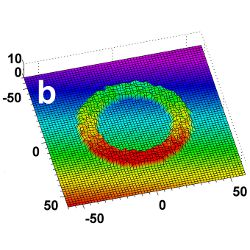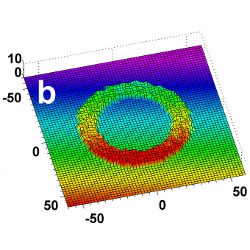
DNA, the building block for our genes, may provide the key to the bottom-up assembly of complex, nanometer-scale circuits, following research performed by scientists based at Harvard University and the Massachusetts Institute of Technology (MIT) that used the biomolecule to carve patterns in graphene lying on the surface of a silicon wafer.
However, researchers need to overcome significant obstacles to make the processes viable on an industrial scale.
Today, integrated circuit (IC) manufacturers use exclusively top-down techniques to define the transistors and wiring that make up ICs based on optical lithography. Light shone through a reticle defines features on a chemical resist spun onto the surface of a silicon wafer. The resist typically hardens where the light strikes but remains soft enough to wash off elsewhere, so that materials can be deposited or implanted in the areas not masked by the resist.
Almost 20 years ago, the semiconductor industry moved to use light in the sub-250nm deep ultraviolet spectrum to try to keep pace with shrinking feature sizes, which reduced to 250nm only a few years later. This led to increasing problems with optical factors such as diffraction. The impact of blurring caused by diffraction increases dramatically as feature sizes approach the wavelength of the light that bends around them.
Since then, because of problems in sourcing compatible materials for much smaller wavelengths, chipmakers have been forced to stick with deep ultraviolet light, now at 193nm. However, the minimum feature size has been reduced tenfold, to less than 25nm. Even in the early 2000s, when the differential was far lower, Dan Hutcheson, analyst and CEO at VLSI Research, likened the practice to “painting a one-inch line using a four-inch brush.”
Chipmakers fought back through the use of increasingly complex masks that contain billions of tiny dummy features. These dummy features introduce constructive and destructive interference that result in the intended circuitry being exposed on the surface of the wafer. Now, however, they are at their limit.
The industry hopes to move to extreme ultraviolet (EUV) light, using a sub-15nm wavelength, but the machines will be expensive and still cannot rival the throughput of today’s deep-ultraviolet equipment. So, the industry has employed a stopgap called double patterning in which different, complementary masks slightly offset from each other expose the wafer in two steps to form a final image. A variant of this process—self-aligned double patterning—points the way toward bottom-up self-assembly.
With the self-aligned version of double patterning, a second resist is coated over the hardened resist left after exposure. Chemical etching that follows eats away all of the resist except for the second resist that lies at the edges of the original, creating two thin lines from the single original. A version of this technique is already used to form the fins of Intel’s recently introduced trigate transistor, and Intel’s Director of Advanced Lithography Yan Borodovsky says repeated chemical processing can perform what he calls “pitch division” many times over. Applied Materials, which supplies resists and other chemicals to the chipmakers, has developed techniques using block copolymers that use similar chemical processes to create more complex, regular features on the surface of a wafer that are templated by the materials left by optical lithography.
According to Lars Liebmann, distinguished engineer at IBM’s Semiconductor R&D Center, self-assembly using block copolymers can yield sub-10nm resolution features in processes that work with today’s lithography equipment. However, the impact on design is severe, he says, forcing designers to use almost entirely regular structures.
DNA may provide a way of making self-assembled structures less regular and ease the job of the chip designer. Michael Strano, based at MIT and a member of the team that used DNA to produce patterned graphene, says: “You cannot program block copolymers the way you can with DNA. Copolymers can yield simple shapes and lines, but you cannot dial in anything else. They cannot make a crossbar or anything like that.”
In the early 1980s, Ned Seeman at the State University of New York demonstrated that strands of DNA could be designed to self-assemble into 3D shapes that could be linked together in large regular lattices. In the mid-2000s, Paul Rothemund of the California Institute of Technology further developed the technique to create what he called “scaffolded DNA origami.”
DNA is made up of sequences of four types of monomer or ‘bases’ that combine into a single-stranded polymer held together by a phosphate backbone. Each monomer binds to a complement through hydrogen bonds. These bonds use the electrostatic attraction between electrons on atoms such as oxygen, and the proton that is the hydrogen nucleus. The difference between the structure of the two pairs of bases means they preferentially bind to each other. Adenine forms two hydrogen bonds with thymine; guanine forms three bonds with cytosine. Further electrostatic interactions help form DNA into its familiar double-helix configuration.
“You cannot program block copolymers the way you can with DNA. Copolymers can yield simple shapes and lines, but you cannot dial in anything else.”
DNA origami works by artificially producing sequences that are not entirely complementary and so do not simply wrap into a 2nm-wide helical ribbon. Rothemund’s original technique combined a scaffold of single-stranded DNA 7,000 bases long with a set of much shorter, ‘staple’ sequences, each designed to bind to two different parts of the scaffold. These staples caused the scaffold to form a series of hairpin loops that, by careful design of the sequences, would form arbitrary shapes such as triangles, stars, letters, and smiley faces. Since then, researchers have used other approaches to increase the complexity and size of the shapes they can produce.
A further possible advantage of using DNA as a programmable structural material is that it can be used to perform computations as it assembles. Researchers like Erik Winfree, based at the California Institute of Technology, have used reactions that sever, shuffle, and displace strands of DNA to perform calculations.
Peng Yin, assistant professor in the Department of Systems Biology at Harvard University, who collaborated with Strano’s team at MIT, said, “Computational assembly provides a fascinating direction to take. We could use rules to assemble blocks. One potential advantage is that you could build very sophisticated structures using a small number of building blocks.
“People get excited about using DNA for pure computation that may not be fruitful because other computers, such as those based on silicon, are already very powerful. I do not expect banks of DNA molecules to compete with an iPhone, but when DNA performs computation, you are integrating computation with molecular physical behavior, instead of just using self-assembly.”
Rothemund says there is still a lot of development to be done before DNA can be relied upon to build electronic structures algorithmically. “It has been shown theoretically that algorithmic self-assembly can grow patterns that would define demultiplexer circuits, for example. This requires the assembly to do a simple computation: counting in binary as it grows. Experimentally, binary counters have been achieved, but their error rates are still quite large; we cannot get them to higher than a few dozen routinely. When tiles attach incorrectly, the counters can jump to other numbers.”
Although DNA has apparent advantages over simple block copolymers, it has significant drawbacks. A strongly hydrophilic material, it does not adsorb readily on some of the materials that may be used for ICs in the future, such as graphene. Also, it cannot survive a number of the processes currently used in industrial semiconductor manufacturing, such as acid and dry-plasma etching.
The Harvard-MIT team solved the problem of adsorbing DNA onto graphene by depositing a layer of another organic material on the surface, to which the DNA more readily attaches. So that the DNA template could act as a mask for the plasma-etching process used to remove unwanted graphene, the group used a technique derived from one developed at Duke University in 2003 to coat the DNA with gold. A downside of the metallization process is that it has a rougher edge than the original DNA, says Strano.
Rothemund says, “Many of the most interesting properties of graphene depend exquisitely on the exact conformation of its edges. Pattern transfer from DNA origami is not high-resolution enough to define these edges, so perhaps some chemical post-process can heal them or help ensure they do not have defects which will hurt their electronic properties.”
An alternative approach to protecting the DNA template may work with more conventional devices. Yin has collaborated with a team based at the University of Pittsburgh to develop techniques to deposit silicon dioxide—a material used to form hardened resists for chipmaking—either around the DNA or in place of it. “The process lets us transfer the shapes of DNA to other inorganic materials,” says Yin, which could include the conventional silicon-based materials used in today’s chipmaking fabs.
“When DNA performs computation, you are integrating computation with molecular physical behavior, instead of just using self-assembly.”
Rothemund says a more viable application may be to use DNA to help attach different materials and nanostructures, such as quantum dots and carbon nanotubes, to ICs. “Conventional lithography has difficulty organizing a lot of these materials,” he says. “In particular, I am excited about metallic nanoparticles because of their optical properties. Researchers have spent years characterizing the unusual optical spectra of clusters of nanoparticles, which were ‘assembled’ by chance. DNA origami has the ability to not only create clusters of nanoparticles, but also to arrange them in regular grids.”
Other biomolecules such as proteins—which are themselves built using the genetic information contained in natural DNA—could be used as programmable polymers that are more resistant to industrial processes, or which bind more easily to chip surfaces.
Says Yin, “We expect the same self-assembly principles could be extended to new materials. The most fundamental thing is that DNA is a digital polymer. You can encode a digital sequence with very specific base pairing, but it is not restricted to DNA; it can be extended to other molecules.”
Strano says DNA currently has an important advantage: “We have not solved the protein-folding problem; their shapes are very difficult to predict computationally. But we have figured out the DNA folding problem. DNA folds in a very unambiguous way, so much that if you have DNA sequences floating around in solution, they will eventually find their complement and fold.”
Similar binding dynamics have been applied to chemically modified forms of DNA and other molecules, such as peptide nucleic acid (PNA), which combines a more robust protein backbone with the complementary bases of DNA. Other significant issues still need to be fixed before programmable digital polymers become industrially useful in building.
“Conventional lithography allows arbitrary patterning over enormous length scales, whereas the largest arbitrarily patterned DNA nanostructures achieved so far are roughly a micron in size. And conventional lithography achieves defect rates which will be difficult to achieve with these self-assembled structures,” Rothemund says.
He adds, “There are some new DNA nanostructures which, with great effort to drive down defect rates, may yield masks which can compete with block copolymers, if directed self-assembly of block copolymers is ever considered practical.”
Further Reading
Rothemund, P.W.K.
Folding DNA to create nanoscale shapes and patterns, Nature 440, 297, Mar. 16, 2006
Zhang, G., Surwade, S.P, Zhou, F., Liu H.
DNA nanostructure meets nanofabrication Chemical Society Reviews 2013, 42, 2488
Jin, Z., Sun W., Ke Y., Shih C-J., Paulus, G.L.C., Wang Q.H., Mu B., Yin, P., Strano, M.S.
Metallized DNA nanolithography for encoding and transferring spatial information for graphene patterning Nature Communications 4, 1663, Apr. 9, 2013
Surwade, S.P., Zhou, F., Wei, B., Sun, W., Powell, A., O’Donnell, C., Yin, P., Liu, H.
Nanoscale growth and patterning of inorganic oxides using DNA nanostructure templates Journal of the American Chemical Society, 135 (18):6778-6781, May 8, 2013





Join the Discussion (0)
Become a Member or Sign In to Post a Comment